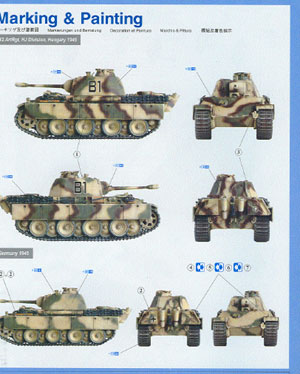Dragon 1/72 Scale Armor Series
Kit No. 7230; PzBeobWg V Ausf. G
by Cookie Sewell
112 parts (105 in grey styrene, 2 screws, 2 in black vinyl, 2 in diecast
metal, 1 section of wire); price USD $8.95.
Advantages: first mass-production kit of this vehicle in this scale; very
nice small details
Disadvantages: diecast hull will make it difficult to cleanly assemble
the kit
Rating: Recommended
Recommendation: For all German Panther and WWII fans
DML continues apace with new small scale releases, and this is the first
time that I can recall that this version of the Panther has been released
in this scale as a mass production kit.
The Germans used tanks for maneuver and suppression of enemy strong
points, but they really relied for the first four years of the war on
artillery and aviation to destroy key enemy targets, However, dedicated
vehicles used for artillery forward observers or aviation forward controllers
were usually isolated fairly quickly and picked off by the opponents.
Therefore, the Germans decided early on to go to a series production tank,
stripped of its main gun and provided with the extra radio sets necessary,
as to be less conspicuous as well as have the ability to move with armored
formations. These tanks existed for the Pzkw. III, Pzkw. IV, and Pzkw.
V (Panther) series tanks.
In 1943 Rheinmetall converted a single Panther to the prototype of the
Panzerbeobachtungswagen V Panther, or armored observation vehicle. This
vehicle lost its main gun; a dummy was fitted along with an MG 34 in the
front of the turret, and a long-base optical rangefinder was discretely
mounted with the heads behind armored flaps at the edges of this new plate.
In 1944-45 the Germans apparently converted 40 more vehicles to this configuration
during rebuilding but they were rarely encountered on the battlefield.
DML has now created a 1/72 version of this tank, using their late G
hull, and done a nice job on the plastic parts for the conversion. The
modeler also does have a wide variety of options for the tow cables as
well – four are provided in styrene as well as the heads for three
more and a length of wire to make them. An engine module is provided for
the rear deck, but no etched parts are included in the way of screening.
Screws hold the model's hull together, with one cleverly hidden under
the forward machine gun position and the other under the engine module.
The hull is alas diecast, which makes smooth assembly somewhat more difficult
in order to get a clean fit. DML has tried to minimize the impact on the
modeler – making some parts single-piece assemblies such as the
spare track links and nearly snap-in fender skirts – but it would
still have been easier for the modeler to make all the parts out of plastic.

Two finishing schemes are provided, one for an artillery regiment with
the "Hitlerjungend" division in Hungary and the other a generic
vehicle in Germany, both 1945.
Overall this is a nice kit, but the diecast metal is still a problem
for less experienced modelers.
Thanks to Freddie Leung of DML for the review sample.
|